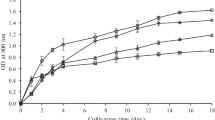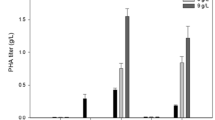Abstract
The Polyhydroxybutyrate (PHB) producer, Bacillus licheniformis MSBN12 was isolated from the marine sponge Callyspongia diffusa. The PHB production of B. licheniformis MSBN12 was optimized using a four-factor Box-Behnken design to find the interactive effects of variables such as palm jaggery, wheat bran, seawater, and incubation temperature. The maximum yield of PHB (6.38 g/L) was achieved through response surface methodology-based optimization and the optimized conditions were further used for the batch and fed-batch fermentation. Maximum biomass was reached at 48 and 36 h of incubation with PHB accumulation of 62.91 and 67.16 % (w/w of dry cells) for batch and fed-batch process. The production of PHB under fed-batch process with B. licheniformis MSBN12 was increased threefold over shake flask culture when palm jaggery as sole carbon source. The ¹H NMR data was extrapolated with peaks of the PHB reference standard and confirmed as PHB analog.






Similar content being viewed by others
References
Kim YB, Lenz RW (2001) Polyesters from microorganisms. Adv Biochem Eng Biotechnol 71:51–79
Khanna S, Srivastava AK (2005) Statistical media optimization studies for growth and PHB production by Ralstonia eutropha. Process Biochem 40:2173–2182
Joa~o MBT, Cavalheiro M, Almeida CMDD, Christian G, Fonseca MMR (2009) Poly (3-hydroxybutyrate) production by Cupriavidus necator using waste glycerol. Process Biochem 44:509–515
Choi J, Sang YL (1997) Process analysis and economic evaluation for poly (3-hydroxybutyrate) production by fermentation. Biopro Eng 17:335–342
Nath A, Dixit M, Bandiya A, Chavda S, Desai AJ (2008) Enhanced production and scale up studies using chess whey in fed batch culture of Methylobacterium sp. ZP24. Bioresour Technol 99:5749–5755
Anderson AJ, Dawes EA (1990) Occurrence, metabolism, metabolic role, and industrial uses of bacterial polyhydroxyalkanoates. Microbiol Rev 54(4):450–472
Li R, Zhang H, Qi Q (2007) The production of polyhydroxyalkanoates in recombinant Escherichia coli. Bioresour Technol 98(12):2313–2320
Castillo LR, Mitchell DA, Freire DMG (2009) Production of polyhydroxyalkanoates (PHAs) from waste materials and by products by submerged and solid-state fermentation. Bioresour Technol 100:5996–6009
Jain SK, Pathak DV, Sharma HR (2000) Alternate carbon substrate for mass production of Rhizobium inoculants. Haryana Agric Univ J Res 30:1–6
Ambati P, Ayyanna C (2001) Optimizing medium constituents and fermentation conditions for citric acid production form Palmyra jaggery using response surface method. World J Microbiol Biotechnol 17:331–335
Van-Thuoc D, Quillaguman J, Mamo G, Mattiasson B (2008) Utilization of agricultural residues of poly (3-hydroxybutyrate) production by Halomonas boliviensis LC1. J App Microbiol 104:420–428
Velappil SD, Boccaccini AR, Bucke C, Roy I (2007) Polyhydroxyalkanoates in gram-positive bacteria: insights from the genera Bacillus and Streptomyces. Antonie von Leeuwenhoek 91:1–17
Weiner RM (1997) Biopolymers from marine prokaryotes. Trends Biotechnol 15:390–394
Chien CC, Chen CC, Choi MH, Kung SS, Wei YH (2007) Production of poly-bhydroxybutyrate (PHB) by Vibrio spp. Isolated from marine environment. J Biotechnol 132(3):259–263
Arun A, Arthi R, Shanmugabalaji V, Eyini M (2009) Microbial production of poly b-hydroxybutyrate by marine microbes isolated from various marine environments. Bioresour Technol 100:2320–2323
Pandian SR, Deepak V, Kalishwaralal K, Rameshkumar N, Jayaraj M, Gurunathan S (2010) Optimization and fed-batch production of PHB utilizing dairy waste and sea water as nutrient sources by Bacillus megaterium SRKP-3. Bioresour Technol 101:705–711
Wang G (2006) Diversity and biotechnological potential of the sponge-associated microbial consortia. J Ind Microbiol Biotechnol 33:545–551
Selvin J, Ninawe AS, Seghal Kiran G, Lipton AP (2010) Sponge-microbial interactions: ecological implications and bioprospecting avenues. Crit Rev Microbiol 36:82–90
Gasse I, Muller H, Berg G (2009) Ecology and characterization of polyhydroxyalkanoate-producing microorganisms on and in plants. FEMS Microbiol Ecol 1–9
Selvin J, Joseph Soniya, Asha KRT, Manjusha WA, Sangeetha VS, Jayaseema DM, Antony MC, Denslin Vinitha AJ (2004) Antibacterial potential of antagonistic Streptomyces sp. Isolated from marine sponge Dendrilla nigra. FEMS Microbiol Ecol 50(2):117–122
Spiekermann P, Rehm BH, Kalscheuer R, Baumeister D, Steinbüchel A (1999) A sensitive, viable-colony staining method using Nile red for direct screening of bacteria that accumulate polyhydroxyalkanoic acids and other lipid storage compounds. Arch Microbiol 171(2):73–80
Kitamura S, Doi Y (1994) Staining method of poly (3-hydroxyalkanotes acids) producing bacterial by Nile blue. Biotechnol Tech 8:345–350
Holt JG, Krieg NR, Sneath PHA, Staley JT, Williams ST (1994) Bergey’s Manual of Determinative Bacteriology, 9th edn. Williamsons and Wilkins, Balitomore
Enkicknap JJ, Kelly M, Peraud O, Hill RT (2006) Characterization of a culturable alphaproteobacterial symbiont common to many marine sponges and evidence for vertical transmission via sponge larvae. App Environ Microbiol 72:3724–3732
Spikema D, Holmes B, Nicholas SA, Blanch HW (2009) Biological characterization of Haliclona (? Gellius) sp: sponge and associated microorganisms. Microbial Ecol 58:903–920
Arun A, Murugappan RM, David Ravindran AD, Veeramanikandan V, Balaji S (2006) Utilization of various industrial wastes for the production of poly-b hydroxy butyrate (PHB) by Alcaligenes eutrophus. African J Biotechnol 5(17):1524–1527
Valappil SP, Misra SK, Boccaccini AR, Keshavarz T, Bucke C, Roya I (2007) Large-scale production and efficient recovery of PHB with desirable material properties, from the newly characterized Bacillus cereus SPV. J Biotechnol 132:251–258
Rawte T, Mavinkurve S (2002) A rapid hypochlorite method for the extraction of polyhydroxyalkanoates from bacterial cells. Indian J Exp Biol 40:924–929
Silverstein RM, Bassler GC, Morrill TC (1991) Spectrophotometric identification of organic compounds, 5th edn. Wiley, New York, pp 15–16
Shrivastav A, Mishra SK, Shethia B, Pancha I, Jain D, Mishra S (2010) Isolation of promising bacterial strains from soil and marine environment for polyhydroxyalkanoates (PHAs) production utilizing Jatropha biodiesel byproduct. Int J Biol Macromol 47:283–287
Panda B, Jain P, Sharma L, Mallick N (2006) Optimization of cultural and nutritional conditions for accumulation of poly-β-hydroxybutyrate in Synechocystis sp.PCC 6803. Bioresour Technol 99:1296–1301
Deepak V, Kalishwaralal K, Ramkumarpandian S, Venkatesh Babu S, Senthilkumar SR, Sangiliyandi G (2008) Optimization of media composition for Nattokinase production by Bacillus subtilis using response surface methodology. Bioresour Technol 99:8170–8174
Uma Maheswar Rao JL, Satyanarayana T (2007) Improving production of hyperthermostable and high maltose-forming alpha-amylase by an extreme thermophile Geobacillus thermoleovorans using response surface methodology and its applications. Bioresour Technol 98(2):345–352
Nonato RV, Mantelatto PE, Rossell CEV (2001) Integrated production of biodegradable plastic, sugar and ethanol. App Microbiol Biotechnol 57:1–5
Kulkarni SO, Kanekar PP, Nilegaonkar SS, Sarnaik SS, Jog JP (2010) Production and characterization of a biodegradable poly (hydroxybutyrate-co-hydroxyvalerate) (PHB-co-PHV) copolymer by moderately haloalkalitolerant Halomonas campisalis MCM B-1027 isolated from Lonar Lake, India. Bioresour Technol 101:9765–9771
Sankhla IS, Bhati R, Singh AK, Mallick N (2010) Poly (3-hydroxybutyrate-co-hydroxyvalerate) co-polymer production from a local isolate, Brevibacillus invocatus MTCC 9039. Bioresour Technol 101:1947–1953
Halami PM (2008) Productions of polyhydroxyalkanoates from starch by the native isolate Bacillus cereus CFR06. World J Microbiol Biotechnol 24:805–812
Yilmaz M, Soran H, Beyatli Y (2005) Determination of poly-b-hydroxybutyrate (PHB) production by some Bacillus spp. World J Microbiol Biotechnol 21:565–566
Kaynar P, Beyatli Y (2009) Determination of poly-b-hydroxybutyrate production by Bacillus spp. isolated from the intestines of various fishes. Fish Sci 75:439–443
Reddy VS, Thirumala M, Mahmoo SK (2009) Production of PHB and P (3HB-co-3HV) biopolymers by Bacillus megaterium strain OU303A isolated from municipal sewage sludge. World J Microbiol Biotechnol 25:391–397
Acknowledgments
This study was supported by grants from the Department of Biotechnology, Government of India, New Delhi. We thank, DSIR-Techno Park Innovation Centre, Kollam for their immense help over bioreactor studies. GSK is thankful to DST-SERB for Young Scientist project.
Author information
Authors and Affiliations
Corresponding author
Rights and permissions
About this article
Cite this article
Sathiyanarayanan, G., Saibaba, G., Seghal Kiran, G. et al. Process optimization and production of polyhydroxybutyrate using palm jaggery as economical carbon source by marine sponge-associated Bacillus licheniformis MSBN12. Bioprocess Biosyst Eng 36, 1817–1827 (2013). https://doi.org/10.1007/s00449-013-0956-9
Received:
Accepted:
Published:
Issue Date:
DOI: https://doi.org/10.1007/s00449-013-0956-9




